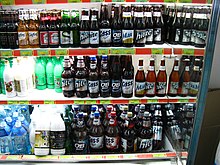| Beer | |
 South Korean beer on display for sale in July 2008 | |
| Korean name | |
|---|---|
| Hangul | 맥주 |
| Hanja | 麥酒 |
| Revised Romanization | maekju |
| McCune–Reischauer | maekchu |
| IPA | [mɛ̝k̚.t͈ɕu] |
Beer, called maekju (Korean: 맥주; Hanja: 麥酒) in Korean, was first introduced to Korea in the early 20th century. Seoul's first brewery opened in 1908.[1] Two current major breweries date back to the 1930s. The third brewery established in Korea, Jinro Coors Brewery, was founded in the 1990s. It was later acquired by Oriental Breweries (OB). Hite Breweries's former name was Chosun Breweries, which was established in 1933. The company changed its name to Hite Breweries in 1998.[2] OB Breweries established as Showa Kirin Breweries in 1933. The company changed its name to OB Breweries in 1995.[3]
The South Korean beer market is currently dominated by two major manufacturers, Hite-Jinro and OB, with several brands being sold in the local market. Most restaurants and bars in Korea only have one of these beer brands on tap (Hite or OB's Cass), as they are largely regarded to be similar in taste and price (they are mostly brewed from rice). Imported beers are widely available in Korea, but are generally expensive - usually costing at least ₩8,000 and as much as ₩15,000 for a pint of Guinness in bars in downtown Seoul, versus approximately ₩3,000 for local brands. Recently[when?], microbreweries have sprouted up throughout the country, showing increasing signs of sophistication. Out of South Korea's mass-produced beers, only two are brewed from 100% barley malt: Max (Hite) and OB Golden Lager.
The lack of microbreweries in the South Korean market is attributed to onerous government regulations. This has constrained small-size brewers from supplying beer to locations under their ownership. These laws were eventually relaxed in June 2011, granting several small players a share in the local beer market.[4]
A growing trend in South Korea is home brewing. While ingredients and supplies are still limited, there are many households brewing their own beer. Various brewing clubs also exist to help guide newcomers through the processes of home brewing in South Korea; one such club being Homebrew Korea.[5]
- ^ Seoul City Guide. Lonely Planet. 2009. ISBN 9781741047745.
- ^ Naver`s Company dictionary, Naver`s Company dictionary (2016-11-28). "THE HITEJINRO CO.,LTD". terms.naver.com.
- ^ Naver`s Company dictionary, Naver`s Company dictionary (2016-11-28). "Oriental Brewery Company". terms.naver.com.
- ^ ""House beer"...Quality Competition Fiercely Allowed". Korean Broadcasting System. August 18, 2013.
- ^ "Homebrew Korea". Archived from the original on 2014-04-29.
© MMXXIII Rich X Search. We shall prevail. All rights reserved. Rich X Search
